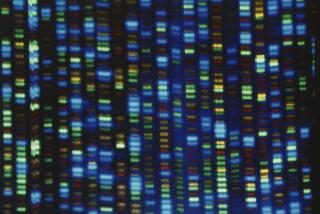Genome Project Enlists High-Tech Help
- Share via
WASHINGTON — Genome hunters at the U.S. Energy Department and Celera Corp. announced a marriage of computer technology and biology Friday, saying they will mine the human gene map for information they hope will transform medicine.
They will team up, along with Compaq Computer Corp., to write powerful computer programs and to build a giant new computer to go through the genome sequence and find out where the genes are and what they do.
“We’re writing the first draft of the future here,” Neal Lane, science advisor to President Clinton, told a news conference. He echoed what scientists have been saying--that deciphering the human genome will transform medicine and basic understanding of biology.
Lane, Energy Secretary Bill Richardson, Sandia National Laboratories President Paul Robinson, Celera President Craig Venter and Compaq Vice President Bill Blake signed the multimillion-dollar agreement Friday.
Because it is a development agreement, they said there is no clear dollar amount involved, but it is expected to total in the tens of millions of dollars.
“These are . . . tools that are necessary to unlock the mysteries of life,” Richardson said.
The human genome was sequenced late last year, but the sequence gives only the code for the human genetic map. Now that code has to be broken.
The A’s, Ts, Cs and Gs that make up DNA repeat in patterns that the body can make sense of, but that look like so much stuttering to the human eye. Computers can find the meaning in the patterns.
Celera made its own sequence, and the publicly funded Human Genome project, which includes the Energy Department, made another. Many genes already are known, but the code is so dense that it is not yet even clear how many genes there are.
Celera already has a big room filled with computers, most of them made by Compaq, to crunch through the genetic information.
Using Compaq’s alpha chip-equipped computers and new algorithms written by Celera’s in-house team, researchers reduced an operation that took nine hours to just five minutes, Venter said. But he said it is clear that more capacity is needed to do the work ahead.
“We need to do that kind of calculation that takes five minutes in a matter of seconds,” he said.
Sandia National Laboratories and Compaq, in consultation with Celera, will design the next generation of supercomputer. They should be able to run 100 trillion operations per second, or 100 teraflops.
IBM says its Blue Gene computer can do 100 teraflops. Blue Gene was designed in part to help model how proteins are folded--an important aspect of taking genetic information into the practical world of biology.
The most advanced computer at the Energy Department’s Lawrence Livermore Labs can do 12 teraflops. One being built now at Los Alamos, where nuclear weapons are designed, will be able to do 30 teraflops.






